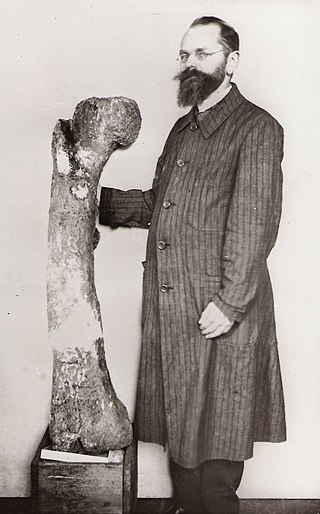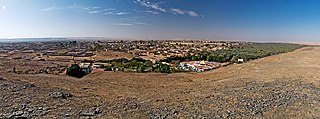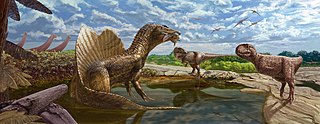Related Research Articles

Spinosaurus is a genus of spinosaurid dinosaur that lived in what now is North Africa during the Cenomanian stage of the Late Cretaceous period, about 100 to 94 million years ago. The genus was known first from Egyptian remains discovered in 1912 and described by German palaeontologist Ernst Stromer in 1915. The original remains were destroyed in World War II, but additional material came to light in the early 21st century. It is unclear whether one or two species are represented in the fossils reported in the scientific literature. The type species S. aegyptiacus is mainly known from Egypt and Morocco. Although a potential second dubious species, S. maroccanus, has been recovered from Morocco, this dubious species is likely a junior synonym of S. aegyptiacus. Other possible junior synonyms include Sigilmassasaurus from the Kem Kem beds in Morocco and Oxalaia from the Alcântara Formation in Brazil, though other researchers propose both genera to be distinct taxa.

Carcharodontosaurus is a genus of large carnivorous theropod dinosaur that lived in Northwest Africa from about 100 to 94 million years ago during the Cenomanian age of the Cretaceous. Two teeth of the genus, now lost, were first described from Algeria by French paleontologists Charles Depéret and Justin Savornin as Megalosaurus saharicus. A partial skeleton initially referred to this genus was collected by crews of German paleontologist Ernst Stromer during a 1914 expedition to Egypt. Stromer did not report the Egyptian find until 1931, in which he dubbed the novel genus Carcharodontosaurus, making the type species C. saharicus. Although this skeleton was destroyed during the Second World War, it was subsequently redescribed as the holotype of a distinct carcharodontosaurid genus, Tameryraptor. In 1995, a nearly complete skull of C. saharicus, the first well-preserved specimen to be found in almost a century, was discovered in the Kem Kem Beds of Morocco, which was officially designated as the neotype in 2007. In the same year, fossils unearthed from the Echkar Formation of northern Niger were described and named as another species, C. iguidensis, though this species might belong to a different genus.

Ernst Freiherr Stromer von Reichenbach was a German paleontologist best remembered for his expedition to Egypt, during which the discovery of the first known remains of Spinosaurus was made.

Bahariya Oasis is a depression and a naturally rich oasis in the Western Desert of Egypt. It is approximately 370 km away from Cairo. The roughly oval valley extends from northeast to southwest, has a length of 94 km, a maximum width of 42 km and covers an area of about 2000 km2.

Aegyptosaurus is a genus of sauropod dinosaur that lived in what is now Africa, around 95 million years ago, during the Late Cretaceous Period.

Carcharodontosauridae is a group of carnivorous theropod dinosaurs. In 1931, Ernst Stromer named Carcharodontosauridae as a family, which, in modern paleontology, indicates a clade within Carnosauria. Carcharodontosaurids include some of the largest land predators ever known: Giganotosaurus, Mapusaurus, Carcharodontosaurus, and Tyrannotitan all rivaled Tyrannosaurus in size. Estimates give a maximum weight of 8–10 metric tons for the largest carcharodontosaurids, while the smallest carcharodontosaurids were estimated to have weighed at least 500 kilograms (1,100 lb).

Bahariasaurus is a dubious, enigmatic genus of large theropod dinosaur. The genus is known to have included at least 1 species, Bahariasaurus ingens, which was found in North African rock layers dating to the Cenomanian age of the Late Cretaceous. The only fossils confidently assigned to Bahariasaurus were found in the Bahariya Formation of the Bahariya oasis in Egypt by Ernst Stromer but were destroyed during a World War II bombing raid with the same raid taking out the holotype of Spinosaurus and Aegyptosaurus among other animals found in the Bahariya Formation. While there have been more fossils assigned to the genus such as some from the Farak Formation of Niger, these remains are referred to with much less certainty. Bahariasaurus is, by most estimations, one of the largest theropods, approaching the height and length of other large bodied theropods such as Tyrannosaurus rex and the contemporaneous Carcharodontosaurus. The aforementioned estimations tend to put it at around 11–12.2 metres in length and 4-4.8 tonnes in overall weight.

Deltadromeus is a genus of theropod dinosaur from the Aoufous Formation of Morocco.

Termatosaurus is a potentially dubious genus of archosaur known from several tooth specimens. Its remains come from the Upper Triassic of France, England, Germany and Switzerland.

Suchosaurus is a spinosaurid dinosaur from Cretaceous England and Portugal, originally believed to be a genus of crocodile. The type material, consisting of teeth, was used by British palaeontologist Richard Owen to name the species S. cultridens in 1841. Later in 1897, French palaeontologist Henri-Émile Sauvage named a second species, S. girardi, based on two fragments from the mandible and one tooth discovered in Portugal. Suchosaurus is possibly a senior synonym of the contemporary spinosaurid Baryonyx, but is usually considered a dubious name due to the paucity of its remains, and is considered an indeterminate baryonychine. In the Wadhurst Clay Formation of what is now southern England, Suchosaurus lived alongside other dinosaurs, as well as plesiosaurs, mammals, and crocodyliforms.

The Bahariya Formation is a fossiliferous geologic formation dating back to the early Cenomanian, which outcrops within the Bahariya depression in Egypt, and is known from oil exploration drilling across much of the Western Desert where it forms an important oil reservoir.

Libycosuchus is an extinct genus of North African crocodyliform possibly related to Notosuchus; it is part of the monotypic Libycosuchidae and Libycosuchinae. It was terrestrial, living approximately 95 million years ago in the Cenomanian stage of the Late Cretaceous. Fossil remains have been found in the Bahariya Formation in Egypt, making it contemporaneous with the crocodilian Stomatosuchus, and dinosaurs, including the famous Spinosaurus. It was one of the few fossils discovered by Ernst Stromer that wasn't destroyed by the Royal Air Force during the bombing of Munich in 1944. The type species, L. brevirostis, was named in 1914 and described in 1915.
Baharijodon is an extinct genus of trematochampsid crocodylomorph. It is known from the Bahariya Formation in Egypt, which dates back to the Cenomanian stage of the Late Cretaceous. The genus is known from a single tooth, which was first figured by Ernst Stromer in 1933, and then named as a new genus of the family Goniopholididae by Oskar Kuhn in 1936. In 1979, Éric Buffetaut and P. Taquet instead referred the tooth to Trematochampsidae.

Paranogmius is an extinct genus of prehistoric bony fish that lived during the Cenomanian. It is known from only 2 partial skulls and several dorsal vertebrae discovered in the Bahariya Formation that was destroyed during World War II. Since then, no more fossils have been discovered. It may have been up to 3 meters long.

Stomatosuchidae is an extinct family of neosuchian crocodylomorphs. It is defined as the most inclusive clade containing Stomatosuchus inermis but not Notosuchus terrestris, Simosuchus clarki, Araripesuchus gomesii, Baurusuchus pachecoi, Peirosaurus torminni, or Crocodylus niloticus. Two genera are known to belong to Stomatosuchidae: Stomatosuchus, the type genus, and Laganosuchus. Fossils have been found from Egypt, Morocco, and Niger. Both lived during the Cenomanian stage of the Late Cretaceous. The skulls of stomatosuchids are said to be platyrostral because they have unusually flattened, elongate, duck-shaped craniums with U-shaped jaws. This platyrostral condition is similar to what is seen in the "nettosuchid" Mourasuchus, which is not closely related to stomatosuchids as it is a more derived alligatoroid that existed during the Miocene.

Onchopristis is an extinct genus of sclerorhynchoid from the Cretaceous of North Africa, Europe, North America, and potentially South America. It contains two valid species, O. numida and O. dunklei, though some researchers argue that both may be considered a single taxon with variation in morphology caused by a wide geographical range. Specimens of Onchopristis have been discovered in coastal and fluvial deposits dated from the Barremian to the Cenomanian ages, making this genus one of the oldest known sclerorhynchoid.

Paralititan was a giant titanosaurian sauropod dinosaur genus discovered in coastal deposits in the Upper Cretaceous Bahariya Formation of Egypt. It lived between 99.6 and 93.5 million years ago.

Richard Markgraf was a German Bohemian paleontologist. He is best remembered for his expeditions to Egypt, which discovered the first known remains of many extinct fossil reptiles, such as Aegyptosaurus, Tameryraptor and Spinosaurus.

Tameryraptor is an extinct genus of large carcharodontosaurid theropod dinosaurs from the Late Cretaceous Bahariya Formation of Egypt. The genus contains a single species, T. markgrafi, known from partial skull bones and vertebrae, and leg bones. The holotype specimen was historically assigned to the genus Carcharodontosaurus, and it was destroyed in a bombing during the Second World War in 1944. Tameryraptor is one of the only African carcharodontosaurids to preserve associated cranial and postcranial remains.
References
- 1 2 R. E. Molnar. (1989). Terrestrial tetrapods on Cretaceous Antarctica. In J. A. Crane (ed.), Origins and Evolution of the Antarctic Biota, Geological Society Special Publication 47:131-140
- ↑ Nothdurft, W.; Smith, J.; Lamanna, M.; Lacovara, K.; Poole, J.; Smith, J. (2002). The Lost Dinosaurs of Egypt . New York: Random House. pp. 133. ISBN 9780375507953.
- ↑ Kuhn, O. (1936). "Weitere Parasuchier und Labyrinthodonten aus dem Blasensandstein des mittleren Keuper von Ebrach". Palaeontographica. 83: 61–98.
- 1 2 "Crocodilia". Paleofile. Retrieved 3 October 2010.
- ↑ O. Kuhn. (1964). Unsolved problems of the phylogeny of amphibians and reptiles. Jahreshefte des Vereins für vaterländische Naturkunde in Württemberg 118/119:293-325
- ↑ O. W. M. Kuhn. (1966). The Reptiles. Systematics and Phylogeny. Krailling bei München: Oeben.